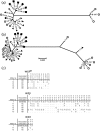Evolution of the capsular gene locus of Streptococcus pneumoniae serogroup 6
- PMID: 20929956
- PMCID: PMC3068628
- DOI: 10.1099/mic.0.043901-0
Evolution of the capsular gene locus of Streptococcus pneumoniae serogroup 6
Abstract
Streptococcus pneumoniae expressing serogroup 6 capsules frequently causes pneumococcal infections and the evolutionary origins of the serogroup 6 strains have been extensively studied. However, these studies were performed when serogroup 6 had only two known members (serotypes 6A and 6B) and before the two new members (serotypes 6C and 6D) expressing wciN(β) were found. We have therefore reinvestigated the evolutionary origins of serogroup 6 by examining the profiles of the capsule gene loci and the multilocus sequence types (MLSTs) of many serogroup 6 isolates from several continents. We confirmed that there are two classes of cps locus sequences for serogroup 6 isolates. In our study, class 2 cps sequences were limited to a few serotype 6B isolates. Neighbour-joining analysis of cps sequence profiles showed a distinct clade for 6C and moderately distinct clades for class 1 6A and 6B sequences. The serotype 6D cps profile was found within the class 1 6B clade, suggesting that it was created by recombination between 6C and 6B cps loci. Interestingly, all 6C isolates also had a unique wzy allele with a 6 bp deletion. This suggests that serotype switching to 6C involves the transfer of a large (>4 kb) gene segment that includes both the wciN(β) allele and the 'short' wzy allele. The MLST studies of serotype 6C isolates suggest that the 6C cps locus is incorporated into many different pneumococcal genomic backgrounds but that, interestingly, 6C cps may have preferentially entered strains of the same genomic backgrounds as those of serotype 6A.
Figures




References
-
- Bogaert, D., De Groot, R. & Hermans, P. W. (2004). Streptococcus pneumoniae colonisation: the key to pneumococcal disease. Lancet Infect Dis 4, 144–154. - PubMed
Publication types
MeSH terms
Substances
Associated data
- Actions
Grants and funding
LinkOut - more resources
Full Text Sources

